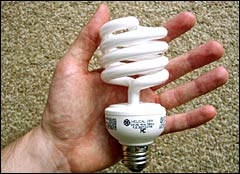Dearest Umbra,
For the past 10 years or so I have been patiently and methodically replacing the incandescent light bulbs in my house with the more efficient compact fluorescent ones. Even though they cost more than incandescents, I have been confident that their lower energy requirements and longer life span more than made up for the increased cost. Thus I was greatly dismayed the other day when I went to our local transfer station and was told that I must dispose of burned out compact fluorescent bulbs as hazardous waste. I was told that this is due to their containing some mercury.
Have I been wrong all this time by going for the more efficient bulbs? I will certainly dispose of my burned out bulbs in a responsible manner, but I dare say others won’t know about this problem and a lot of them will end up in landfills. Will we thus end up with more mercury (and/or other nasties) in the environment? Please consult your oracle and tell me which evil is the lesser.
John
Barrington, N.H.
Dearest John,
Why add suspense to summer’s heat: The answer is no. You have not gone wrong.
For the past five years or so I have been patiently touting compact fluorescent light bulbs and methodically deleting most of the letters decrying the mercury they contain. Bored with the topic and tired of repeating myself, I consulted no oracles. Until last week, when my Hazardous Waste Oracle and I were having a social chat and he happened to mention a nice math problem. I will convey his oracular arithmetic and hope it helps some of you CFL holdouts correctly allocate your mercury worries.
Compact fluorescent bulbs are an inexpensive, simple change one can make at the household level to reduce energy use. As home energy use is reduced, several problems upstream are addressed. For starters, electricity generation is lessened. Electricity in the United States is generated from dams, coal, natural gas, oil, nuclear, wind, etc., and most regions use a mix of all these sources. Cutting electricity use reduces the emission of mercury, a heavy metal that is a neurotoxic byproduct of coal-burning power plants. Mercury is integral to the functioning of fluorescent lamps, and can either be reclaimed from said lamps upon disposal or exude into the environment when improperly disposed. One cost/benefit calculation in buying CFLs for your home, therefore, is whether net mercury releases increase or decrease.
My Hazardous Waste Oracle shares the following calculation: On average, a U.S. kilowatt-hour generates .012 milligrams of mercury. So, a 20-watt CFL running for a (shorter than expected) lifetime of 10,000 hours would generate 2.4 mg of mercury, while a comparable 75-watt incandescent running for 10,000 hours (you would need more than one bulb, of course), would generate 9.0 mg. A big difference, as you can see. Add in the 5 mg of mercury that might reside in a CFL bulb (the high average I saw) and you get a total of 7.4 mg — still less than the incandescent.
The American Council for an Energy Efficient Economy, an oracle available to all of us, tells us that CFLs keep two to 10 times as much mercury out of the environment as they contain. ACEEE calculates 6.5 mg mercury saved from the environment by using a CFL, with numbers even higher in states that rely heavily on coal power. The EPA’s CFL fact sheet estimates 3.6 mg of mercury avoided during a five-year period of bulb use.
The EPA even developed a computer model for “Mercury Emissions from the Disposal of Fluorescent Lamps.” I mention it for those of you who would like to add all the “what if” questions, such as: what if the bulb contains 12 mg, what if the bulb falls off the truck, what if I want to compare divalent and particulate mercury, etc. The agency was very open about its background data, and happy to share the model itself.
What this simple math does not address (mine, I mean, not the EPA’s very large document holdings) is the differences between mercury emissions from power generation and bulb disposal. We can all help with the mercury issue by doing our job at the disposal end. And do I need to point out that mercury is only one savings when we reduce energy by using more efficient light bulbs? No, no.
Hgly,
Umbra



